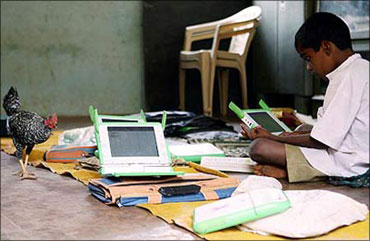Photographs: Reuters
India has unveiled a $30 'laptop' which makes it the world's cheapest computing device.
Human Resource Development Minister Kapil Sibal unveiled the Rs 1,500-device meant especially for students. It will be available in 2011 in the markets.
The device is a Linux-based machine with videoconferencing, word processing and browsing capabilities, and has a solar-powered add-on.
It is said to have 2 GB onboard memory, Wi-Fi connectivity, Ethernet port(s) and USB connectivity. However, it does not have a screen. So if you want to display the data stored on it, you would need to attach a compatible output device using the USB ports.
And the computing device called 'Sakshat' is 10 inches long and five inches wide and costs around $50.
To make it useful for the students, especially in the rural areas, the scientists have made it low power consuming gadget.
. . .
This is the $30-laptop developed in India!
Image: The OLPC's XO Laptop which costs $188. India's $30-laptop will now be the cheapest.Photographs: Sanjay Sawant
While unveiling the low-cost device, the minister said that when more manufacturers decide to produce similar devices, prices will fall even further.
In February 2009, the HRD ministry (then headed by Arjun Singh) said that this 'laptop' would be available for only $10. The laptop has been jointly developed by several organisations, such as the University Grants Commission, the Indian Institute of Technology-Madras, and the Indian Institute of Science, Bangalore.
The project had created a major buzz in the laptop industry across the world and many questions over the development of such a low-cost 'laptop'. Many players were curious to know the details of the costing and how Indians managed to keep the cost so low.
When the contraption was shown in 2009, it fell extremely short on expectations -- some called it nothing short of a joke, even 'hoax'.
The confusion was primarily being caused by the description of this low-cost computing device as a laptop.
. . .
This is the $30-laptop developed in India!
The low cost laptops will be distributed in institutions by the HRD ministry. The final price will depend on the transportation cost.
Like the National Mission on Education through ICT, the device is said to be aimed at improving the skills of students, both at the school and higher levels. Under the mission the government also intends to provide high-speed Internet access to the schools to download e-books and e-journals and other material. Students will be able to download the material through the 'Sakshat' portal.
The goal of the national mission is to increase the enrolment in higher education in the country by 5 per cent over the next five years. The government will subsidise 25 per cent of broadband connectivity costs for private and public colleges.
The $30 'laptop' is being seen as India's reply to One Laptop per Child's XO and Classmate of Intel. The XO, created by scientist Nicholas Negroponte and MIT Media Lab was originally targeted to cost only $100 but by the time it was ready to enter the market its cost went up to $188. The Classmate notebook PC from Intel was priced at $300 a piece.




article